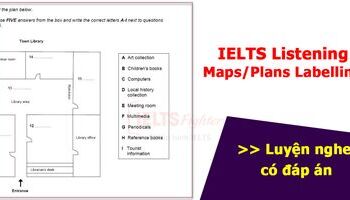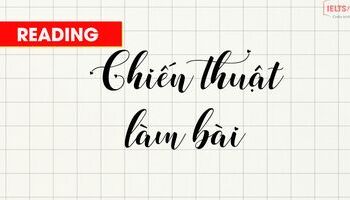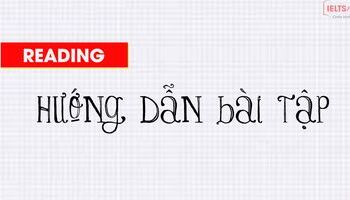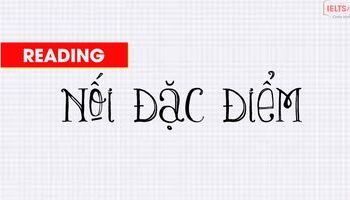Trong IELTS Listening, MAPS/PLANS LABELLING là dạng câu hỏi thường gặp và khiến những ai mới bắt đầu luyện nghe cảm thấy hoang mang không biết dán nhãn như thế nào cho đúng?
Giới thiệu bài Map/Plan labelling
Map/Plan Labelling là dạng bài yêu cầu điền vào chỗ trống đáp án phù hợp với các địa điểm trên bản đồ/sơ đồ. Dạng bài này hay xuất hiện trong phần 2 của bài Listening.
Trong Listening, Map/Plan Labelling xuất hiện:
- Đề bài được ra dưới dạng bản đồ/sơ đồ mặt bằng cùng các đáp án tương ứng với địa điểm trên bản đồ
- Có nội dung liên quan tới đời sống hàng ngày, đưa thông tin về một sự kiện hay một địa điểm nào đó
- Bài yêu cầu chọn đáp án đúng hoặc điền từ vào chỗ trống
| QUESTION 5-7 Label the plan below Write NO MORE THAN THREE WORDS AND/OR A NUMBER for each answer. Plan Labelling
QUESTION 1-5 Label the map below Write NO MORE THAN THREE WORDS AND/OR A NUMBER for each answer. Languages of the different regions of Spain Map Labelling
|
Từ vựng quan trọng
Đối với bài thi về Map/Plan Labelling, chúng ta cần phải xây dựng vốn từ vựng liên quan đến “Direction” - Phương hướng và “Location” - Vị trí. Khi đó, các bạn mới có thể follow được các chỉ dẫn của bài nghe.
Nhiều bạn nói rằng bài này khó bởi vì vốn từ về cách chỉ phương hướng, vị trí. Vì vậy, khi mới bắt đầu làm dạng bài này IELTS Fighter khuyên các bạn nên mở phần tapescript và gạch chân các từ vựng liên quan đến “direction” và “location” nhé.
Những từ vựng về vị trí và phương hướng, địa điểm
- At the top/at the bottom: Ở trên cùng/ ở dưới cùng
- On the left/on the right/on the far side: ở bên trái/ bên phải/ ở phía xa
- North/South/East/West: Bắc/ Nam/ Đông/Tây
- To the north/to the west: ở phía Bắc/ ở phía Tây
- Slightly west of: chếch phía Tây
- In the southwest/in the northeast: Phía Bắc/ phía Tây
- In the middle of/in the centre of: Ở giữa / Ở trung tâm của
- Above/below: trên/ dưới
- Inside/outside: bên trong/ bên ngoài
- Opposite/in front of: đối diện / phía trước
- Left-hand side/ right-hand side: bên trái/ bên phải
- Clockwise/anticlockwise: Ngược chiều kim đồng hồ/ ngược chiều kim đồng hồ
- A little beyond: Xa hơn một chút
- Just pass: Đi qua, hãy đi qua
- Before you get to: Trước khi bạn đến
- Adjoining: Liền kề
- Enter via: Nhập qua
- Runs alongside: Chạy cùng
- give directions: chỉ đường
- leave the main building: rời khỏi tòa nhà chính
- path: con đường
- take the right-hand path: rẽ vào đường bên phải
- on the left// on the right: bên trái// bên phải
- opposite…// face…: đối diện…
- go past// walk past…: đi ngang qua…
- at the crossroads: tại ngã tư
- turn left// turn right: rẽ trái// rẽ phải
- take the first left// take the first right: rẽ trái tại ngã rẽ thứ nhất// rẽ phải tại ngã rẽ thứ nhất
- take the second left/ take the second right: rẽ trái tại ngã rẽ thứ hai// rẽ phải tại ngã rẽ thứ hai
- on the corner: trong góc
- next to: kế bên
- go straight: đi thẳng
- entrance: lối ra vào
- traffic lights: đèn giao thông
- east/ west/ south/ north: đông/ tây/ nam/ bắc
- roundabout: vùng binh, vòng xoay
- cross the bridge// go over the bridge: băng qua cầu
- go towards…: đi hướng về phía nào
- bend(v): uốn vòng, uốn cong
- walk/ go along…: đi dọc theo…
- at the top of…// at the bottom of…: phía trên…// dưới phía…
- in front of…: phía trước…
- behind = at the back of….: phía sau…
- before you get to…// before you come to…: trước khi bạn đi tới…
- in the middle of…/ in the centre of…: ở giữa…// ở trung tâm…
- to be surrounded by…: được bao quanh bởi…
- at the end of the path: phía cuối con đường
- the main road: tuyến đường bộ chính
- the railway line: tuyến đường xe lửa
- run through…: chạy xuyên qua
- walk through…: đi xuyên qua
- go upstairs// go downstairs: đi lên lầu// đi xuống lầu
- theatre: rạp hát
- car park: chỗ để xe
- national park: công viên quốc gia
- (flower// rose) garden: vườn (hoa// hoa hồng)
- circular area: khu vực hình tròn
- picnic area: khu vực dã ngoại
- wildlife area: khu vực động vật hoang dã
- bird hide: khu vực ngắm các loài chim
- information office: văn phòng thông tin
- corridor: hành lang
- foyer: tiền sảnh
- ground floor: tầng trệt
- basement: tầng hầm
- auditorium: phòng của khán giả, thính phòng
- stage: sân khấu
- maze: mê cung
- tower: tòa tháp
- post office: bưu điện
Chiến lược làm bài 4 bước
STEP 1: ĐỌC KỸ CÂU HỎI VÀ XÁC ĐỊNH SỐ TỪ CẦN ĐIỀN NẾU CẦN THIẾT
- ONE WORD ONLY - Điền một từ duy nhất
Bạn chỉ được phép được điền một từ duy nhất.Ví dụ: Nếu điền là “a pen” câu trả lời của bạn sẽ là sai, phải viết là “pen”
- ONE WORD AND/OR A NUMBER - Điền một từ và/ hoặc một số
Câu trả lời của bạn có thể là một từ, một số, hoặc một từ và một số. Ví dụ: September, hoặc 12th, hoặc 12th September
- NO MORE THAN TWO WORDS AND/OR A NUMBER - Điền không quá hai từ và/hoặc một số
Câu trả lời của bạn có thể là một từ, một số, một từ và một số, hai từ, hai từ và một số. Ví dụ: 15 Bank Road. Nếu như bạn nhìn thấy chỉ dẫn này, thì phần lớn các câu trả lời đều là hai từ hoặc hai từ và một số.
- NO MORE THAN THREE WORDS - Điền không quá ba từ
Câu trả lời của bạn có thể là một từ, hai từ hoặc ba từ. Nếu bạn nhìn thấy chỉ dẫn này, thì phần lớn các câu trả lời đúng đều là điền ba từ
STEP 2: NGHIÊN CỨU KỸ MAP/PLAN
2.1 Nhìn vào sơ đồ. Nối các cụm a-f với các địa điểm 1-3 trên sơ đồ.

1. Right next to the washroom _____
2. Beside the river _____
3. At the riverfront _____
4. The furthest away from the river _____
5. In the center of the camp _____
6. Right in the middle of everything _____
2.2 Nhìn vào bản đồ. Nối các cụm a-f với các địa điểm 1-6 trên sơ đồ.

1. Towards the north east _____
2. At the southernmost point _____
3. Along the west coast _____
4. Slightly inland from the north coast _____
5. In the far north-west corner _____
6. In the interior _____
Trước khi làm bài, chúng ta cần xác định:
- Các địa điểm có trên biểu đồ, sơ đồ là gì
- Xác định mỗi hướng của bản đồ/sơ đồ có địa điểm gì
- Nhìn vào phần chính của map/plan để hiểu và thấy được hình ảnh liên kết của các phần thông tin. Với bản đồ, vẽ một la bàn theo 4 hướng Đông Tây Nam Bắc với vị trí trung tâm để hiểu bản đồ. Để ý kỹ những địa điểm gần với chỗ trống cần điền, đây chính là gợi ý của chúng ta khi nghe băng
STEP 3: XÁC ĐỊNH ĐIỂM BẮT ĐẦU CỦA BẢN ĐỒ
Với một số bản đồ/sơ đồ sẽ có đánh dấu điểm bắt đầu (có thể là dấu X) nhưng có một số bản đồ/sơ đồ không đánh dấu, vì vậy chúng ta sẽ phải nghe băng và xác định được điểm bắt đầu của bài nghe. Sau khi đã xác định được vị trí bắt đầu, chúng ta nên đánh dấu bằng bút chì.

Đánh dấu sẵn điểm bắt đầu
2.3 Nghe và xác định điểm bắt đầu trên bản đồ sau:

STEP 4: NGHE THEO CHỈ DẪN TRONG BĂNG
2.4 Nghe và điền từ vào chỗ trống
- Nghe và điền những từ chỉ “direction” - phương hướng
A: Hi Jean how are you settling into life at University.
B: Fine, except I don’t really know what there is to do in town. I haven’t had time to look around yet you’ve been here for a year – could you give me some ideas?
A: Of course! There’s lots of places for students. Firstly, if you ___________- the bridge over the river outside the campus and __________ … oh no, sorry, that’s the garage… _________, then you’ll get to the bowling alley, which is really popular at the weekends because it’s so close to the campus. On Friday nights they have a special discount for students.
- Nghe và điền những từ chỉ “location” - vị trí
Welcome to the resort!
I’ll just tell you about some of our facilities. We have got a lovely little pond, where guests are welcome to sit in have a picnic. You’ll see it as you come in the entrance. __________________ of the resort, you’ll see a circular courtyard, it has some lovely cool places to sit as well. You can see all famous fig tree from there, it’s enormous! _____________ of the courtyard, you’re find a small shop where you can pick up things like postcards and stamps. It’s just__________ the tree.
2.5 Nghe và chọn xem đâu là hướng đi đúng trong hai bản đồ?

NHỮNG ĐIỀU CẦN LƯU Ý
| Trong băng thường sẽ xuất hiện những đáp án gây nhiễu để khó xác định được đáp án chính xác, các bạn hãy chú ý lắng nghe những từ nối như “but”, “however”, “so”,... để nắm được đáp án chính xác nhé |
Luyện tập bài Map
2.6
QUESTIONS 5-7
Label the plan below.
Write NO MORE THAN TWO WORDS AND/OR A NUMBER for each answer.

2.7.
QUESTIONS 5-7
Label the plan below.
Write NO MORE THAN TWO WORDS AND/OR A NUMBER for each answer.

2.8 QUESTIONS 7-10
Label the map below.
Write NO MORE THAN THREE WORDS AND/OR A NUMBER for each answer.
Proposed field trip itinerary
Visit the North County 8 ________

SCRIPT
2.3
Okay, Group B, your turn. Does everyone have a copy of the plan? Great. Okay, we’ll all be meeting in the car park – that’s on the bottom of the plan, see?
2.4
.Direction
A: hi Jean how are you settling into life at University.
B: Fine, except I don’t really know what there is to do in town. I haven’t had time to look around yet you’ve been here for a year – could you give me some ideas?
A: of course! There’s lots of places for students. Firstly, if you go across the bridge over the river outside the campus and turn left … oh no, sorry, that’s the garage… turn right, then you’ll get to the bowling alley, which is really popular at the weekends because it’s so close to the campus. On Friday nights they have a special discount for students.
Location
Welcome to the resort!
I’ll just tell you about some of our facilities. We have got a lovely little pond, where guests are welcome to sit in have a picnic. You’ll see it as you come in the entrance. In the middle of the resort, you’ll see a circular courtyard, it has some lovely cool places to sit as well. You can see all famous fig tree from there, it’s enormous! To the right of the courtyard, you’re find a small shop where you can pick up things like postcards and stamps. It’s just behind the tree.
2.5
A: Can you tell me how to get to the supermarket?
B: Sure, let me have a think. We’re in the Bridge Street now and it’s in Queens Road.
A: Oh, the only street I know is Riverside Street. I know my hotels on the corner there.
B: That’s right. You need to go up Bridge street as far as the traffic lights, then turn right. That’s Riverside Street.
A: I see.
A: Then you walk along there to the next set of traffic lights and you’ll be at Queens Road. You turns left there and is the second shop on your left.
B: Thanks very much.
2.6
Leisure centre
manager: Now some of you won’t have been to Park Hill Leisure Centre before, so let me just tell you a little about the layout. As you can see, the reception area here is very spacious, and there is plenty of room to meet your friends and have a drink. We also have brand-new dance studios with floor-to- ceiling mirrors and the latest audio equipment. The dance studios are to the left of the reception area, behind the swimming pool. No ... sorry ... I meant opposite the swimming pool. Both the roller skating and skateboarding classes will be held in the Skate Arena. This has also been refurbished and we have a new five-metre ramp in there which is proving to be popular. The arena is behind the changing rooms, which you can see behind us. between the gym and tennis courts. The tennis courts are on the right of the arena. You’ll see both of these new spaces on the tour later.
Now, the final thing I want to talk about is how to join the Park Hill Leisure Centre and enrol for the classes. First you need to complete an enrolment form with some of your personal details, including your address and telephone number and the name of your school. If you’re under sixteen years old, then you’ll also be required to get your parents’ permission to take part in the classes. Please ask one of vour parents to sign the authorisation form attached to the enrolment form. You’ll find the form in your information pack. When you’ve done this, you just hand the forms to reception. You can pay an annual subscription of twenty pounds, or alternatively, you can pay each time you use the facilities. There is a one pound sixty admission fee in this case. Whether you decide to pay in one go or with each visit, you still need to complete the forms in your pack and become a member. Once we have the forms, we’ll send vour membership card to vour home address. All you need to do is show this card every time you come to the centre, and if you want to book a class, you just need your membership number on your card.
2.7
A: I can't give you a tour now, I'm afraid. I have to stay here at the Help Desk but I can show you places on this map of the library.
B: That would be helpful, thanks.
A: OK, so we're here at the Help Desk, next to the Service Desk, where you go to borrow and return books. The maximum number of books you can borrow at any one time is ten.
B: Yes, I see.
A: Opposite the Service Desk is the Training Room, which is used by library staff to give demonstrations of the computer systems to staff and students. But the entrance is round the other side.
B: Is the Training Room beside the Quiet Room?
A: Yes, that's right, with the entrance round the front too. It's important to remember that all mobile phones must be switched off in this room.
B: Of course. And what about books - where can I find the books for my course?
A: Good question. You're studying Geography so, if you walk past the Service Desk, turn right, no sorry turn left, and continue on past the Philosophy section. vouTl find the Geography section. The copying facilities are on the left. Now one more important thing is the Group Study Room and the booking system. If you're working on a project with other students and you want to discuss things with each other, you can go to the room in the corner at the opposite end of the library from the copiers. That’s the Group Study Room. It’s between the Sociology section and the TV room. The Group Study Room must be booked forty-eight hours in advance.
B: Right, thanks. Can I keep this map?
A: Actually, this is the last one I have, but I can make a copy for you.
B: That would be great, thanks.
A: Oh, I should also explain how you book the Group Study Room.
B: Oh, yes, so how do I do that?
A: You can only book this room using the online reservation system. The same one you use to reserve books that are currently on loan.
B: I thought it was called the online catalogue system.
A: No, that's for searching for things in the library; the reservation system is what you use to make a room booking.
B: And can I access that from outside the library?
A: Yes, via the library website. You will need to enter the name and student number of each student in the group too, so make sure you have these to hand when you make the booking. But all this is explained on the home page of the website. Once you’ve made your reservation request, you’ll receive a confirmation email from the library to sav whether your booking has been successful or not. If not, you can try to arrange another time.
B: Well that sounds fairly easy.
A: Yes, you'll be fine. It's all quite straightforward really.
B: Thanks.
2.8
| Anna: | Well, shall we look at our route now? Most of the speakers we're looking for are in California, so we could start there. We can spend two weeks travelling around and meeting people to get some background information and then start collecting data. |
| Suzanne: | What do you think about beqinninq in the south-west corner of the state and visiting the Barona |
| Anna: | reservation? That's a good idea. We'll be able to get some interviews with native language speakers there. And then we could go to the eastern mountains to visit the local education authority of North Country - |
| James: Anna: James: | they’ve got a native language project for school children. Why there? Wouldn’t it be better to go to the education department in San Diego? It's bigger. But they focus more on Spanish and English bilingualism and less on native languages. In that case, the North Countv Education Authority will be more valuable so let's do that. After that, we could head south-east to the town of Bishop. There's a company there called Co-Tech, which employs only bilingual speakers. I've emailed the manaqinq director, who's happy to give us an interview. |
| Suzanne: James: Anna: | That's great work, James! It sounds like something we should definitely do. Right, well I’ll email her to confirm. Also, we should go to Sun City. It's this bilingual town in the south central area of the region. They have a policy whereby all signs in the town must be in the local language as well as English. We can |
| Suzanne: Anna: | take photos of these signs - they'll make good visuals for our report. But won't that be intrusive for the people who live there? No, they're used to it - the village is used as a model for other communities who'd like to do the same thing. |
| Suzanne: | In that case, let's add it to the itinerary. |
KEY
2.1
1. b,c
2.a,d
3. e,f
2.2
1. c
2. e
3. d
4. a
5. f
6. b
2.3
Starting Point: CAR PARK
2.4
go across - turn left - turn right
in the middle - to the right - behind=
2.5
A.
2.6
Dance Studios
Changing Rooms
Tennis Courts
2.7
Training,
Philosophy,
TV room
2.8
Questions 7-10
reservation
(local) education authority/ department
the managing director,
take photos of
Nguồn tham khảo:
The Official Guide to IELTS for Academic & General Training - Pauline Cullen
Listening for IELTS - Fiona Ash & Jo Tomlinson
HACKER IELTS Listening
Đặc biệt là ngay trong tháng này thì IELTS Fighter hiện đang có chương trình ưu đãi học phí siêu hấp dẫn cho các bạn học viên mới, đừng bỏ qua nhé:







